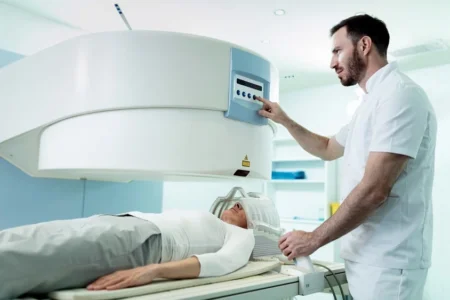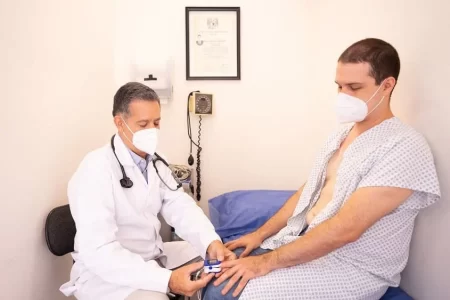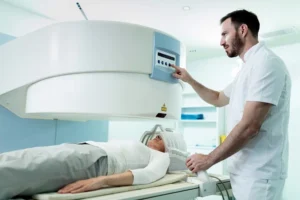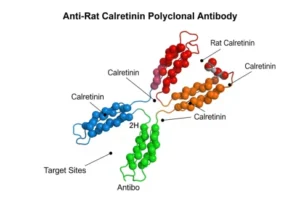How to Differentiate If Your Symptoms Are Due to Enlarged Prostate or Prostate Cancer?
- Updated on: Jun 29, 2024
- 3 min Read
- Published on Dec 1, 2020

Enlargement of the prostate occurs when the prostate gland’s cells start multiplying, leading to inflammation of the prostate gland. Prostate cancer occurs due to the abnormal and uncontrolled growth of the cells present within the prostate gland.
Does Enlarged Prostate Mean Cancer?
Many people think that prostate cancer and enlarged prostate cancer are associated, but it is not right. Enlarged prostate begins from the central part of the prostate gland, while prostate cancer starts in the prostate gland’s peripheral zone. Both the conditions may appear common, but they don’t cause each other. Prostate cancer is malignant and can spread from the source of its origin to other body parts. On the contrary, an enlarged prostate is benign (non-cancerous) and cannot spread from its original source. 1 out of every 7 men may be diagnosed with prostate cancer, and 1 out of every 2 men may be diagnosed with an enlarged prostate in their old age.
Read Signs and Symptoms of Prostate Cancer
Read Testing and Diagnosis of Prostate Cancer
What Are the Symptoms of Enlarged Prostate and Prostate Cancer?
Though enlarged prostate and prostate cancer have almost similar symptoms, sometimes it becomes difficult to differentiate the two. The urethra squeezes as the prostate grows due to any reason. This pressure on the urethra prevents the urine from coming out of the body via the urethra. Prostate cancer symptoms generally don’t appear until cancer has attained enough growth to pressurize the urethra. Following are some of the common symptoms of an enlarged prostate and prostate cancer:
- Urgent need for urination (urinary urgency)
- Frequent urination or nocturia
- Troubled urination
- Weak urinating system
- Feeling of fullness in the bladder every time.
In the early stages of prostate cancer, symptoms don’t appear until they have reached an advanced stage. Prostate cancer patients may notice these symptoms:
- Painful urination with a burning sensation
- Blood in the urine (Hematuria)
- Erectile dysfunction (trouble in erection)
- Painful ejaculation
- Pain in the lower back, pelvic, thigh, and chest
- Blood in semen
- Weakness in legs
How Can Diagnostic Tests Help in Differentiating Between Enlarged Prostate and Prostate Cancer?
Following are some of the tests that may help in distinguishing an enlarged prostate from prostate cancer:
Digital Rectal Examination
In this test, the healthcare professional/ doctor uses his index finger to feel the prostate gland through the rectum’s front wall. This is done to check for any abnormality within the prostate gland. If the gland has increased in size, its enlargement may be felt by the doctor with his finger. If the patient has an enlarged prostate, the doctor may feel it as a smooth and firm structure, while if it is prostate cancer, the gland may be felt as a hard and lumpy structure.
Prostate-Specific Antigen (PSA) Assessment
The prostate gland secretes a protein called prostate-specific antigen (PSA), which is normally present in the blood, but its level increases with age. PSA is significantly raised in both enlarged prostate as well as prostate cancer. However, in the case of an enlarged prostate, the rise of PSA is not significant, but in prostate cancer, the PSA elevates significantly.
Transrectal Ultrasound Examination
To perform this test, a probe is inserted into the rectum, and ultrasound waves are used to detect the prostate gland’s size and to check tumors. Unless cancer has spread beyond the prostate, this test cannot differentiate between an enlarged prostate and prostate cancer.
Transurethral Resection of the Prostate
Transurethral resection of the prostate (TURP) is a surgical procedure, most commonly used to check an enlarged prostate by removing prostate pieces obstructing nearby structures such as the urethra. The physician preserves a sample of the excess prostate tissue and sends it for further analysis (biopsy) to check cancer.
FAQs
Does an Enlarged Prostate Affect a Man Sexually?
If a person has an enlarged prostate, he may experience sexual problems. But there are medications like terazosin (Hytrin) or tamsulosin (Flomax) that can helpful in relaxing prostate and bladder muscles. Studies have reported the connection between enlarged prostate and prostate cancer.
Is Coffee Bad for Your Prostate?
Caffeine can harm both the prostate and the bladder. If a person has BPH or enlarged prostate, he should make an effort to reduce the caffeine intake by cutting back on coffee, soda or energy drinks. Caffeine avoidance can make a big difference in his urinary health. An important drink for prostate is water.
Can an MRI Detect Prostate Cancer?
MRI is a valuable tool to detect prostate cancer in men with persistently elevated levels of protein-specific antigen (PSA) levels in spite of having negative prostate biopsy. MRI may provide biopsy target information. Accordingly, treatment can be given to a patient.
What Is the Latest Treatment for Enlarged Prostate?
Doctors at UC San Diego Health are now performing prostate artery embolization (PAE) as a new treatment for men with benign prostatic hyperplasia (BPH), or an enlarged prostate. In PAE, doctor uses X-rays and other advanced imaging technique to see inside the body and treat conditions without surgery. It is an alternative to surgery, with no hospital stay, minor operative pain and less expensive.













1 Comment
I like this blog very much so much excellent information.